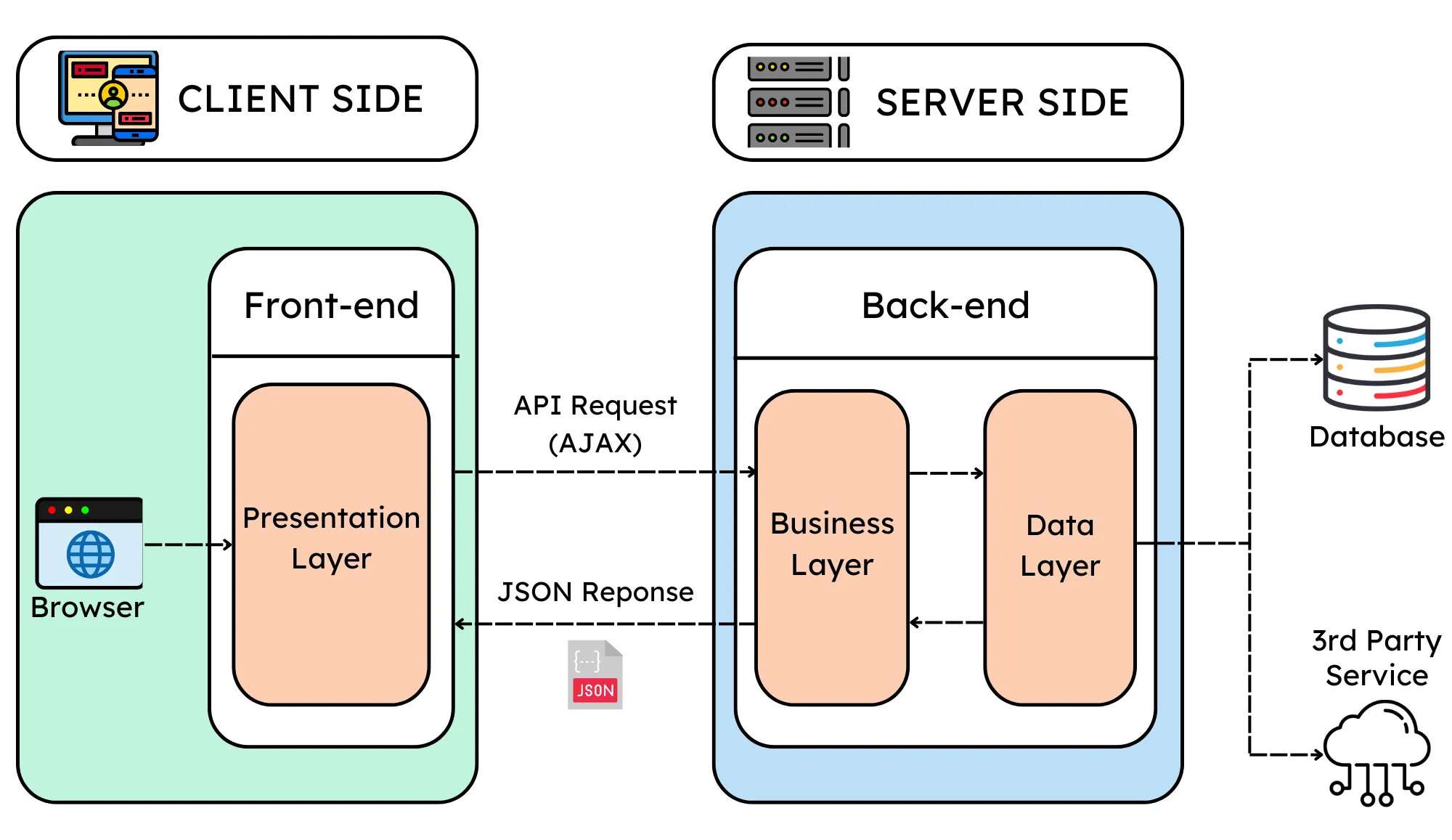Have you ever experienced a website that feels more like an app? You can easily switch between features without any annoying page reloads. That's the magic of Single Page Applications (SPAs)! This technology revolutionizes the way we interact with websites, offering a faster, smoother, and more engaging experience.
But, what exactly is an SPA? And is it the right choice for every website? In this blog, we'll break down everything you need to know about SPAs. We'll explore how they work, the benefits they offer for both users and developers, and some things to consider before diving in.
>> Read more:
- Top Reasons Why Web Development Is So Important
- Web Development Skills To Become A Good Web Developer
- 9 SignsYour Business Needs A Web Application
What is A Single Page Application?
A Single Page Application (SPA) is a website or web app that loads a single HTML page and updates its content dynamically using JavaScript. Unlike traditional websites that reload a whole new page for every click, SPAs provide a smoother and more app-like experience. Think of Gmail or Facebook - you can navigate between features without that constant refreshing.
Pros and Cons of SPAs Compared to Traditional Multi-Page Applications
Pros
- Improved User Experience: SPAs feel faster and more responsive due to minimal page reloads. Navigation is smoother, and interactions are more dynamic.
- Better Engagement: SPAs can offer a more app-like experience, keeping users engaged long-term.
- Potential Performance Gains: After the initial load, SPAs can be faster since only certain data is updated, not the whole page.
- Code Reusability: SPAs often have reusable UI components which makes development and upkeep easier.
Cons
- SEO Problems: Search engines may have difficulty indexing SPAs because they are always changing.
- Initial Load Time: SPAs can take longer to load initially due to downloading all the necessary JavaScript libraries.
- Complexity: Development can be harder than with regular websites. It requires developers to be familiar with JavaScript frameworks.
Here is a table summarizing the key differences between SPAs and MPAs
|
Feature |
Single Page Application (SPA) |
Multi-Page Application (MPA) |
|
User Experience (UX) |
Faster, smoother, more app-like feel. |
Slower due to frequent page reloads. |
|
Performance |
Potentially faster after initial load. |
Faster initial load, consistent performance. |
|
Development Complexity |
More complex due to JavaScript frameworks. |
Generally simpler. |
|
SEO Friendliness |
Can be challenging for search engines to index dynamic content. |
SEO friendly, content easily crawlable by search engines. |
|
Navigation |
Seamless, no full page reloads. |
Traditional clicks lead to full page reloads. |
|
Scalability |
Great for real-time updates and data-heavy applications. |
More scalable for large, content-driven websites. |
|
Examples |
Gmail, Facebook, Netflix. |
Most traditional websites, online stores, blogs. |
How A Single Page Application (SPA) Works?
Normally, traditional websites load an entire HTML page for every click or navigational action. With frequent interactions, this can come out as awkward and slow. SPAs take a different approach:
- The Initial Load: The user first opens the SPA, the browser fetches a single HTML page. This page contains the core layout, initial content, and, crucially, JavaScript code.
- JavaScript Takes Center Stage: The downloaded JavaScript code acts as the brain of the SPA. It handles user interactions (clicks, form submissions, navigation, etc.).
- Fetching Data Behind the Scenes: When you interact with the SPA, the JavaScript code doesn't reload the entire page. Instead, it uses a technique called AJAX (Asynchronous JavaScript and XML) to send targeted requests to the server. These requests ask for specific pieces of data needed to update the current view.
- The Server Fulfills the Requests: The server receives the data request from the JavaScript code and retrieves the relevant information from the database. It then sends this data back to the browser in a format the SPA can understand (usually JSON).
- Content Transformation: Once the data arrives, the SPA's JavaScript code takes over again. It manipulates the existing HTML content on the page using the DOM (Document Object Model). This allows it to update specific sections of the UI (like displaying new product information or refreshing a social media feed) without affecting the rest of the page.

Architecture of Single Page Applications (SPAs)
While SPAs offer a seamless user experience, there's a specific architecture behind the scenes that makes it all work. Here's a breakdown of the key components:
Client-side (Frontend)
This is where the user interacts with the SPA. It primarily consists of:
- HTML: The initial HTML page provides the basic structure and layout of the SPA.
- JavaScript: This is the brain of the SPA. It handles user interactions, fetches data from the server using APIs (Application Programming Interfaces), and updates the UI dynamically.
- Client-side Framework: Popular frameworks like React, Angular, or Vue.js offer pre-built components, data binding, routing, and state management functionalities, simplifying SPA development.
>> Read more about state management in React:
- Demystifying React Redux for Centralized State Management
- Mastering React Query: Simplify Your React Data Flow
Server-side (Backend)
This side handles data storage, processing, and communication with the client-side. It includes:
- Server: Delivers the initial HTML page and processes API requests for data.
- Database: Stores the application data that the server retrieves and sends back to the client upon request.
- API Endpoints: These are defined URLs that the client-side JavaScript code uses to fetch specific data from the server.

Ideal Scenarios for Building SPAs
- Real-time Applications: SPAs are ideal for situations where information needs instant updates for everyone, like collaborative tools, chat applications, and social media news feeds. The need for full page reloads is eliminated, creating a smooth and responsive experience.
- Focused Experiences: SPAs are well-suited for dashboards displaying real-time data, product pages with dynamic filtering and reviews, etc. They allow users to navigate and interact with information efficiently without interruptions from page loads.
- Content-Heavy Applications: SPAs excel at content-heavy applications with frequent updates, such as news websites with ever-changing headlines, interactive tutorials with progressive lessons, and online portfolios with work samples. Users can easily switch between content sections without reloading the website, keeping them interested.
- Mobile-first Experiences: SPAs can be optimized for smartphones and tablets as mobile browsing grows. They provide a native app-like experience without requiring a download, making information available on the go.
Best Practices for Building Single Page Applications (SPAs)
- Leverage frameworks: Utilize React, Angular, or Vue.js for pre-built components, streamlined development, and efficient code.
- Optimize performance: Focus on code splitting, lazy loading, and caching for a faster user experience.
- Prioritize UX: Ensure accessibility, progressive enhancement, and responsive design for all users across devices.
- Manage state effectively: Use state management libraries for complex SPAs and keep component logic focused on UI.
- Security first: Sanitize user input, secure APIs, and enforce HTTPS for data protection.
- SEO optimization: Consider server-side rendering and proper meta tags for better search engine visibility.
- Test and monitor: Implement unit testing, end-to-end testing, and performance monitoring for a polished final product.
>> Read more:
- A Step-by-Step Guide to Website Development Process
- Top 12 Web Development Trends to Watch in 2024
Conclusion
In conclusion, Single Page Applications (SPAs) have revolutionized the way we interact with web content. SPAs improve responsiveness, smoothness, and app-likeness by reducing frequent page reloads.
Obviously, SPAs are a powerful tool for creating engaging and interactive web experiences. However, carefully consider their shortcomings before diving in. By understanding the ideal scenarios and best practices for development, you can leverage their strengths to build applications that keep users engaged and significantly minimize their weaknesses.
At Relia Software, our web development expertise extends to Single Page Applications (SPAs). We create dynamic and responsive web experiences that keep users engaged. Let's contact us today for free consultation.
>>> Follow and Contact Relia Software for more information!
- Web application Development
- web development

